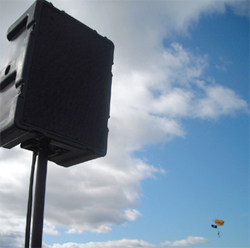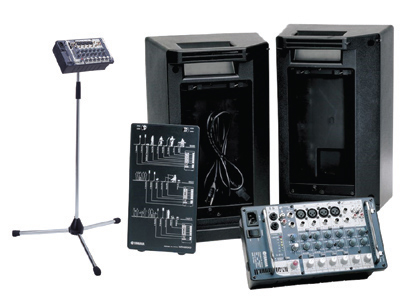
Meanwhile, QSC Audio GX Series amplifiers have become a staple in driving portable systems, featuring Class H topology that’s based on key elements of the premium PLX Series, while the recently introduced Crown Audio XLS Series amplifiers integrate advanced crossover, limiting and DSP.
When it comes to packages, there are a plethora of packages.
The Yamaha STAGEPAS Series offers passive loudspeakers, powered mixer and cables. A nifty facet is that the powered mixer is actually housed in one of the loudspeakers, and is detachable.
There are dozens of choices in this genre, ranging from professional caliber down to more “prosumer” models that even incorporate CD and mp3 players and a wireless microphone receiver within the loudspeaker system cabinet.

Sometimes, just a powered loudspeaker about the size of a loaf of bread equipped with a mic input will do the trick, and these can also come in handy for spot monitoring in support of larger systems.
Plenty Of Choices
Whether it’s independent components or a package, every portable PA system usually includes these basic items:
• Microphones (and sometimes direct boxes)
• Mixer and power amplifier, or powered mixer, or mixer and powered loudspeakers
• A pair of loudspeakers
• Loudspeaker stands, microphone stands
• Mic, line-level and loudspeaker cables
• Optional items include floor monitors, direct boxes and a mic snake
Let’s look more closely at each component.
Microphones. Step one is figuring out how many mics (and mic inputs) are needed. Unidirectional dynamic mics work well for speech, singers, guitar amps and drums, while unidirectional condenser stand-mounted mics are a solid choice for acoustic instruments as well as singers. Presenters and singer can also be outfitted with headphone mics, and acoustic instruments with mini clip-ons.
Power Amplifiers. How much power do you need? If you’ve already got loudspeakers or are going to purchase them, follow the recommended power guidelines provided by the manufacturer. Levels of a powerful system can always be tuned down to match the application, so be sure not to go too light in terms of output.
That said, here are some very loose guidelines:
• Speech-only system in medium room: 50 watts continuous per channel
• Folk music in a coffee shop with 50 seats: 25 to 250 watts
• Folk music in a medium-size auditorium, club or house of worship with 150 to 250 seats: 95 to 250 watts
• Folk music at a small outdoor festival (50 feet from loudspeaker to audience): 250 watts
• Pop or jazz music in a medium-size auditorium, club or house of worship with 150 to 250 seats: 250 to 750 watts
• Pop or jazz music in a 2,000-seat concert hall: 400 to 1,200 watts
• Rock music in a medium-size auditorium, club or house of worship with 150 to 250 seats: at least 1,500 watts
• Rock music at a small outdoor festival (50 feet from loudspeaker to audience): At least 1,000 to 3,000 watts
